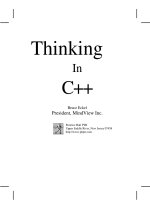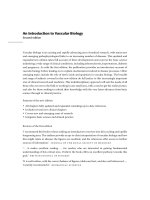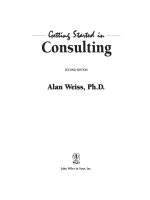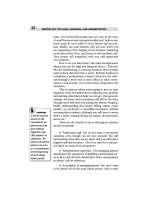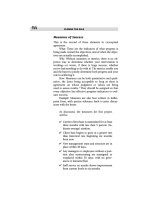Market microstructure in practice, second edition
Bạn đang xem bản rút gọn của tài liệu. Xem và tải ngay bản đầy đủ của tài liệu tại đây (14.13 MB, 364 trang )
www.allitebooks.com
10739_9789813231122_tp.indd 1
29/12/17 11:30 AM
b2530 International Strategic Relations and China’s National Security: World at the Crossroads
This page intentionally left blank
www.allitebooks.com
b2530_FM.indd 6
01-Sep-16 11:03:06 AM
www.allitebooks.com
10739_9789813231122_tp.indd 2
29/12/17 11:30 AM
www.allitebooks.com
10739_9789813231122_tp.indd 1
29/12/17 11:30 AM
www.allitebooks.com
10739_9789813231122_tp.indd 2
29/12/17 11:30 AM
Published by
World Scientific Publishing Co. Pte. Ltd.
5 Toh Tuck Link, Singapore 596224
USA office: 27 Warren Street, Suite 401-402, Hackensack, NJ 07601
UK office: 57 Shelton Street, Covent Garden, London WC2H 9HE
Library of Congress Cataloging-in-Publication Data
Names: Lehalle, Charles-Albert, editor. | Laruelle, Sophie, editor.
Title: Market microstructure in practice : 2nd edition / [edited by]
Charles-Albert Lehalle (Capital Fund Management, France & Imperial College London, UK),
Sophie Laruelle (Université Paris-Est Créteil, France).
Description: Second Edition. | New Jersey : World Scientific, [2018] | Revised edition of
Market microstructure in practice, [2014] | Includes bibliographical references and index.
Identifiers: LCCN 2017045429 | ISBN 9789813231122
Subjects: LCSH: Capital market. | Finance. | Stock exchanges.
Classification: LCC HG4523 .M2678 2018 | DDC 332/.0415--dc23
LC record available at />British Library Cataloguing-in-Publication Data
A catalogue record for this book is available from the British Library.
Copyright © 2018 by World Scientific Publishing Co. Pte. Ltd.
All rights reserved. This book, or parts thereof, may not be reproduced in any form or by any means,
electronic or mechanical, including photocopying, recording or any information storage and retrieval
system now known or to be invented, without written permission from the publisher.
For photocopying of material in this volume, please pay a copying fee through the Copyright Clearance
Center, Inc., 222 Rosewood Drive, Danvers, MA 01923, USA. In this case permission to photocopy
is not required from the publisher.
For any available supplementary material, please visit
/>Desk Editor: Shreya Gopi
Typeset by Stallion Press
Email:
Printed in Singapore
Shreya - 10739 - Market Microstructure in Practice.indd 1
19-10-17 5:25:57 PM
January 2, 2018
8:50
Market Microstructure in Practice
9in x 6in
b3072-fm
Foreword
Robert Almgren, President and Cofounder of Quantitative
Brokers
Fragmentation, the search for liquidity, and high-frequency traders:
These are the realities of modern markets. Traditional models of
market microstructure have studied the highly simplified interaction
between an idealized market-maker or specialist and a stream of
external orders that may come from noise traders or informed
traders. In the modern marketplace, the market itself is replaced
by a loosely coupled network of visible and hidden venues, linked
together by high-frequency traders and by algorithmic strategies.
The distinction between market-makers who post liquidity and
directional traders who take liquidity no longer exists. All traders are
searching for liquidity, which may be flickering across many different
locations with varying latencies, fill probabilities, and costs. That is
the world this book addresses, treating these issues as central and
fundamental rather than unwelcome complexities on top of a simple
framework.
This market evolution is the farthest one in equity markets,
thanks in large part to their size, social prominence as indicators
of corporate value, and large variety of active traders from retail
investors to sophisticated proprietary operations and large fundamental asset managers. Regulation has also been most active in
equity markets, most importantly Reg NMS in the US and MiFiD in
Europe. Other asset markets, such as foreign exchange, futures, and
fixed income, are further back along this pathway, but it is clear that
v
page v
January 2, 2018
vi
8:50
Market Microstructure in Practice
9in x 6in
b3072-fm
Market Microstructure in Practice
the direction of evolution is toward the landscape treated in this book
rather than back to simpler times. Regulation will continue to shape
further development of all these markets, and all market participants
have an interest in increasing their as well as the regulators’ broad
understanding of the underlying issues.
The central focus of the book is liquidity: Loosely speaking, the
ease and efficiency with which large transactions can be performed.
For any real user of the market, this is the primary concern,
although academic researchers may focus on other aspects. Thus,
fragmentation and high-frequency trading are addressed from this
point of view. Throughout the book, the emphasis is on features of
the marketplace that are of tangible and pressing concern to traders,
investors, and regulators.
The authors have extensive personal experience of the development of the European equity markets as traders and as participants
in conversations with regulators and other interested parties. They
bring this experience to bear on every aspect of the discussion as well
as deep quantitative understanding. The resulting book is a unique
mixture of real market knowledge and theoretical explanation. There
is nothing else out there like it, and this book will be a central resource
for many different market participants.
Bertrand Patillet, Deputy Chief Executive Officer of CA
Cheuvreux until April 2013
MiFID I removed the freedom of national regulators to maintain
the secular obligation to concentrate orders on historical markets. In
this way, the regulation, without a doubt, lifted the last regulatory
obstacle preventing Europe from experiencing — for better or for
worse perhaps — the macro and microstructural changes already at
work on North American markets. This complete shift in paradigm
was to render obsolete our savoir-faire and knowledge of how equity
markets work.
We needed to observe, analyse, understand, and, to a certain
extent, anticipate and foresee the consequences of the transformations underway that would drastically change the structure of inter
and intramarket liquidity and thus the nature of the information
page vi
January 2, 2018
8:50
Market Microstructure in Practice
9in x 6in
b3072-fm
Foreword
page vii
vii
conveyed by order books, the right reading of which is vital to
obtaining the best price for our clients. Only then could we redefine
our approach to best execution and adapt our behaviour and our
tools.
We could not have achieved this task without resources, hitherto
the monopoly of certain hedge funds or derivatives desks, but
unknown to agency brokers, namely, profiles capable of extracting
useful information from market data in order to better model
new behaviours, validate or invalidate intuitions and ultimately
provide our traders with buy or sell decision-making tools in these
exceedingly complex markets. This is why, as early as 2006, we
decided to form a team of quantitative analysts with strong links
to the academic world, and headed by Charles-Albert, newly hired
at Crédit Agricole Cheuvreux. This move was to transform our
execution practices beyond our expectations and place us among
the leaders.
Before MiFID II imposes new rules for structuring financial markets, this book provides a point of view, far from the preconceived
ideas and pro domo pleas of such and such a lobby, on market
microstructure issues — the subject of impassioned, fascinating,
and as yet unclosed debate — which will interest all those who,
in one respect or another, are concerned with improving how equity
markets work.
Philippe Guillot, Executive Director, Markets Directorate,
Autorité des marchés financiers (AMF)
When Charles-Albert asked me to write a foreword for his book on
market microstructure, in which many of the topics are reminiscent
of the uncounted hours spent discussing them while we were at
Cheuvreux, he specifically asked for one (alas, only one) of the many
analogies I use to help people getting a grasp on microstructure. A
good proportion comes from comparing the electronics markets to
aviation, with a big difference worth noting: At the beginning of
aviation, as Igor Sikorsky said, the chief engineer was almost always
the chief test pilot, which had the fortunate result of eliminating poor
engineering at an early stage in aviation (could we do something
January 2, 2018
viii
8:50
Market Microstructure in Practice
9in x 6in
b3072-fm
Market Microstructure in Practice
similar for algos?). When comparing the two today, what is probably
missed the most in the market microstructure is common sense.
How can this be illustrated through MiFID? At first glance, one
clear beneficiary of MiFID is Mr. Smith. When he bravely buys 500
shares of Crédit Agricole, the reduction in tick sizes that occurred
in the previous years means that rather than having to pay 6.95
per share when he crosses the spread, he now buys them at 6.949
(he still crosses the spread but, because his dealing size remained
smaller than the Average Trade Size, he still buys from the best offer)
and saves a whopping 0.5 every times he deals. Unfortunately,
whenever he does so, he is never sure that the price he has dealt at
is the one he has seen on his screen nor that the marketplace where
he has dealt is the one in which he was looking at the price. Add to
that some literature on HFT, predatory strategies and flash crashes:
No wonder the markets have lost Mr. Smith’s confidence. Where is
the analogy with aviation?
When today’s engineers build an Airbus A380, they could really
simplify the problems by building it without windows when only
one out of six passengers sits next to one of them. The body of the
plane would not have to be reinforced around the panels and a lot
of weight would be saved. Add to that the reduction of drag when
flying and you could expect that some of these savings would be
passed to the passengers, maybe 0.5 every time he buys a plane
ticket.
Sadly, Mr. Smith and many of his fellow travellers are not yet
ready to fly in a windowless plane for a 0.5 saving (you may also
have noticed that on automatic tube lines, there is always a huge
windowpane at the front of the train in the unlikely event that there
is a risk of a head on crash with another train). Even if it is technically
possible today to fly a plane without a pilot, even if every serious
accident that occurred in this century has a human error to its origin,
the plane industry has realised how important it is to keep the trust
of the customers.
Today, the markets have lost the trust of their most precious
customer, the most humble link in the markets ecosystem: the
uninformed trader. The ecosystem is damaged and repairing it will
be our biggest challenge in the coming years. Although politicians
page viii
January 2, 2018
8:50
Market Microstructure in Practice
9in x 6in
b3072-fm
Foreword
page ix
ix
may decide to make big bold changes, technicians and regulators
have to carefully use their considerable weight on the delicate levers
of market microstructure.
Charles’ and Sophie’s book on market microstructure will
improve our knowledge and consequently help us to tweak these
potentiometers. In promoting better education, this book is at the
roots of restoring trust in the markets.
Albert J. Menkveld, Professor of Finance at VU University
Amsterdam and Research Fellow at TI-Duisenberg School
of Finance
We go to markets to buy and sell. Perhaps, the oldest market still
around is the farmer’s market. Even New York City has them with
farmers driving their vans out to Manhattan to sell their wares at the
local square amid high-rises. It is a pleasant experience to go out on
a sunny day and buy your veggies fresh from the farmer.
That seems a far way off from modern securities markets.
Exchanges have moved from floor trading to servers that match
incoming buy and sell orders. These orders, in turn, were submitted
through electronic channels after traders typed them into their
terminals. Better yet, it seems that even the ’typing’ is increasingly
left to robots to gain speed. So, in today’s markets, decisions are
taken and trades go off at sub-millisecond speed. The clock speed of
a human brain is about 100 ms.
The market place itself changes at a speed that is hard to keep up
with. Practitioners, academics, and regulators all wonder whether
these new electronic markets are better. But what is the appropriate
measure? To an economist, securities markets should get the assets
in the hands of those who have highest value for them (given budget
constraints). The assets should be allocated optimally. Furthermore,
an important byproduct of trading is “price discovery”. Prices
reveal information about the fundamental value of a security. They
help shareholders discover poor management and take appropriate
action.
This book provides a perspective on today’s markets. It reviews
institutional changes, discusses them, and provides color through
January 2, 2018
x
8:50
Market Microstructure in Practice
9in x 6in
b3072-fm
Market Microstructure in Practice
real-world examples. It focuses mostly on European securities
markets. This does not make it less relevant in a global context as the
issues are very similar outside of Europe.
This perspective is an important contribution to the public
debate on modern markets. In the end, we might have gained from
automated markets as costly human intermediaries are replaced by
computers. And when a robot monitors the market for us, we will
have more time to go out and enjoy the farmer’s market.
page x
January 2, 2018
8:50
Market Microstructure in Practice
9in x 6in
b3072-fm
Preface
Preface of the editors to the second edition
The last four years have seen some changes in market microstructure.
We took the occasion to publish an augmented edition of “Market
Microstruture in Practice”. First of all, a new wave of regulations,
driven by MiFID 2 in Europe, is coming. They give a better view on
what regulators and the industry have in mind. More electronization,
and hence more transparency and less information asymmetry, and
more regulation of some important parameters of the microstructure
(like the tick size, the trade reporting process, or circuit breakers). The
main assumptions we took in the first edition of this book went into
these directions, hence it is not necessary to modify what we wrote
four years ago, just to be more accurate.
Moreover, progresses have recently been made on the understanding of market microstructure, and they deserved to be included
in this book. Mainly: Orderbook dynamics (or simply intraday liquidity dynamics), and optimal trading (the science of slicing a large
metaorder to minimize its impact while taking care of the market
risk). In between these two topics lies market impact; here again
academic studies, using big databases of metaorders, offer a better
understanding of the action of the pressure of large orders on the
price formation process. Orderbook dynamics were not addressed in
the first edition, it is documented in this edition; optimal trading was
in the first edition, but we added some useful technical developments
in the mathematical appendix, and we augmented the explanation of
market impact of large orders in accordance with recent convincing
xi
page xi
January 2, 2018
xii
8:50
Market Microstructure in Practice
9in x 6in
b3072-fm
Market Microstructure in Practice
academic papers. Some illustrations have been updated too because
adding four years of data can be useful.
This book is clearly centered on equity markets, simply because
the migration to electronic trading for equities has been well documented and understood. It seems clear other markets (especially the
fixed income market) are following a similar story. When needed, we
added some specific comments on the bond market and on options.
The reader should be able to apply what we understood on equities
to other asset classes, but it is too early to give figures and to draw
conclusions on these other markets.
Once again, this book is the product of a common work and not
just by the two main editors. Stéphanie Pelin and Matthieu Lasnier
have been of great help for this second edition.
Charles-Albert Lehalle, Senior Research Advisor at Capital
Fund Management and former Global Head of Quantitative
Research at Crédit Agricole Cheuvreux
This book results from the conjunction of recent academic research
and day-to-day monitoring of the equity market microstructure evolutions. Academic research simultaneously targeted the emergence
of a scientific framework to study the impact of market design and
agent behaviours on the price formation process (see [Lehalle et al.,
2010b, Lehalle, 2012]) and to model and control the execution costs
and risks in such an ecosystem (see [Lehalle, 2008, 2009], [Guéant
et al., 2012a, 2012b], [Bouchard et al., 2011]). This book aims to keep its
content not too technical. Readers interested in a deeper quantitative
approach will find more details and pointers in the appendix.
Market microstructure monitoring has been motivated by
brokerage-oriented business needs. One of the roles of an intermediary is to provide unbiased advices on available investment instruments; an execution broker should provide independent analyses on
the price formation process. It sheds light on the market valuation
of financial instruments. This is one of the reasons why this book
owes a lot to Crédit Agricole Cheuvreux’ Navigating Liquidity series
([Lehalle and Burgot, 2008, Lehalle and Burgot, 2009a, 2009b, Lehalle
and Burgot, 2010, 2010a, 2012]). Moreover, internal discussions at
page xii
January 2, 2018
Preface
8:50
Market Microstructure in Practice
9in x 6in
b3072-fm
page xiii
xiii
CA Cheuvreux (mainly with Bertrand Patillet and Philippe Guillot)
as well as intense debates with regulators and policy-makers (like
Laurent Grillet-Aubert and Kay Swinburne) on the consequences of
recent evolutions of the microstructure required us to merse these
academic and practical viewpoints to find at least partial answers.
Academics usually do not answer questions that broadly. They
choose one specific case or one market context and try to model
and explain it as much as they can. It does not mean that they
have no intuition. But they cannot afford to claim anything without
strong evidence, and the never-ending fluctuations of regulations
and market conditions do not help. Interactions with academics
are nevertheless of paramount importance in making progresses to
answer regulators and policy-makers’ questions.
Public lectures are no less crucial to mature the outcome of
the dialog with academics — especially when attendees are smart,
talented students. It was my luck that Nicole El Karoui and Gilles
Pagès gave me the opportunity to teach market microstructure
and quantitative trading in their famous Master of Arts Program
in Mathematical Finance since 2006, and a few years later that
Bruno Bouchard suggested I address the same topics in front of
students of University Paris Dauphine. My understanding of market
microstructure, adverse selection, and optimal trading progressed
a lot thanks to passionate discussions with experts like Robert
Almgren, Thierry Foucault, Albert Menkveld, and Ivar Ekeland. The
latter invited me to give a one-week lecture at a summer school at
the MITAC-PIMS (University of British Columbia), giving birth to
challenging exchanges about statistics of high-frequency processes
and stochastic control with Bruno Bouchard, Mathieu Rosenbaum,
and Jérôme Lebuchoux.
Conferences play an important role in the maturation of ideas.
The 2010 Kolkata Econophysic Conference on Order-driven Markets
enriched my viewpoints on the study of market structure thanks to
Frederic Abergel, Fabrizio Lillo, Jim Gatheral, and Bernd Rosenow.
The CA Cheuvreux TaMS (Trading and MicroStructure) workshop
at the Collège de France and the FieSta (Finance et Statistiques)
seminar at École Polytechnique, driven by Mathieu Rosenbaum,
January 2, 2018
xiv
8:50
Market Microstructure in Practice
9in x 6in
b3072-fm
Market Microstructure in Practice
Marc Hoffman, and Emmanuel Bacry, contributed to create a small
group of researchers in Paris focused on the topics of this book. It has
been strengthened by the organization of the 2010 and 2012 “Market
Microstructure: Confronting Many Viewpoints” Paris Conferences,
under the auspices of the Louis Bachelier Institute.
The collaborative process giving birth to academic papers
demands to confront one’s viewpoints with co-authors. It is a strong
source of new ideas and breakthroughs. This book hence owns a
lot to Ngoc Minh Dang, Olivier Guéant, Julien Razafinimanana,
Mauricio Labadie, Joaquin Fernandes-Tapia, Weibing Huang, JeanMichel Lasry, Pierre-Louis Lions, Aimé Lachapelle, Gilles Pagès, and
Sophie Laruelle. The day-to-day work in an algo trading quant team
is made of debates to sharpen a common understanding of the price
formation process. Not only the co-authors of this book, but Edouard
d’Archembaud, Dana Croize, Nicolas Joseph, Matthew Rowley, and
Yike Lu took part in this wonderful adventure. Yike had enough
energy and a wide enough knowledge to read the last version of this
book, giving us last minute comments, correcting our English and
helping us in clarifying some points.
Last but not least, the tone of this book owns a lot to my previous
life in automotive and aerospace industry, during which Robert
Azencott taught me how to use applied mathematics to discover
relationships on the fly inside high-dimensional datasets. It is worth
while to mention the similarity between the realtime control of the
combustion of an automotive engine (with the need to inject enough
fuel to produce the desired energy, taking care not to inject too
much fuel to avoid pollution and degradation of the combustion
process) and the optimal trading of a large order (buying or selling
fast enough to extract the expected alpha of the market, but not too
fast to avoid market impact, disturbing the price formation process
at its own disadvantage). These proximity may be why eight years
ago, when I considered to switch to the financial industry, JeanPhilippe Bouchaud told me I would find it interesting to study
market microstructure and optimal execution; I thank him a lot
for that.
page xiv
January 2, 2018
8:50
Market Microstructure in Practice
9in x 6in
b3072-fm
Preface
page xv
xv
Sophie Laruelle, Assistant Professor at Paris-Est Créteil
University (UPEC) in the Laboratory of Analysis and Applied
Mathematics (LAMA)
How did I come to be concerned about market microstructure? The
answer to this question begins with the answer to how I come to be
concerned about financial mathematics.
I began a course at Rouen University in 2002 in mathematics
and in 2004, with the enforcement of the reform about university
autonomy in France, I started a bachelor’s degree in applied mathematics with economics and finance. As I liked these new fields, I
decided to continue my course in this way with a master’s degree
in actuaries and mathematical engineering in insurance and finance
still at Rouen university, then in Paris at UPMC (Paris VI university)
with the so-called Master “Probabilities and Finance” in 2007 and
finally with a Ph.D. in 2008 under the supervision of Gilles Pagès
on numerical probabilities applied to finance because I wanted to
extend my knowledge in this field.
I began to work on stochastic approximation theory and I met
Charles-Albert Lehalle in 2009 owing to Gilles Pagès; we started
to work together on our first paper on optimal split of volume
among dark pools. I discovered in this way market microstructure,
starting with the different types of trading destinations and their
associated characteristics. Then I collaborated with Charles to do the
practical work associated with his course on quantitative trading in
the Masters course “Probabilities and Finance” in 2010: We used a
market simulator to teach students the implementation of trading
strategies in front of real market data. Then we worked on optimal
posting price of limit order with Gilles and Charles (our second
paper), still using stochastic approximation algorithm to solve this
execution problem.
In parallel, I attended several conferences on market microstructure and I talked at some of them. I found the community
interested in this subject is diversified: Economists, mathematicians,
physicists, etc. Confronting these different viewpoints is very enriching and compatible.
January 2, 2018
xvi
8:50
Market Microstructure in Practice
9in x 6in
b3072-fm
Market Microstructure in Practice
The market microstructure gives academics and professionals
new problems to deal with in modeling, mathematical and computational viewpoints: Which price model to use (the dynamics in
high-frequency data is not the same as on a daily basis), how to
take into account the price discretization (tick size), which statistics
to use (problems like signature plot and Epps effect), which model
will take into account the market impact, how to take into account
the market fragmentation (Lit Pools, Dark Pools), how to model the
limit order book, how to model the interactions between the different
market participants, how to build optimal trading strategies (optimal
control or forward optimization) and how to implement them, how
to understand the impact of trading strategies on the market (like the
flash crash in May 6, 2010), etc. This list is not exhaustive and there
are lots of other questions that the study of market microstructure
produces. There is still work to be done to better understand and
model all its characteristics with both empirical studies and academic
contributions while discussing too with regulators. The mixing of
different kinds of studies and people make market microstructure
a rich and active environment. We tried in this book to deliver the
keys to understand the basis of all these questions in a quantitative
yet accessible way.
page xvi
January 2, 2018
8:50
Market Microstructure in Practice
9in x 6in
b3072-fm
About the Editors
Currently Senior Research Advisor at
Capital Fund Management (CFM),
Charles-Albert Lehalle is an international expert in market microstructure and optimal trading. Formerly
Global Head of Quantitative Research
at Crédit Agricole Cheuvreux and Head
of Quantitative Research on Market
Microstructure in the Equity Brokerage
and Derivative Department of Crédit
Agricole Corporate Investment Bank, he has been studying the
market microstructure since regulatory changes in Europe and in
the US took place. He provided research and expertise on this topic
to investors and intermediaries from 2006 to 2013. He was also a
member of the Scientific Committee of the French regulator (AMF).
His is a prominent voice often heard by regulators and policymakers such as the European Commission, the French Senate, the
UK Foresight Committee, etc.
xvii
page xvii
January 2, 2018
xviii
8:50
Market Microstructure in Practice
9in x 6in
b3072-fm
Market Microstructure in Practice
Currently Assistant Professor at Université Paris-Est Créteil (UPEC) and Associate Researcher at École Polytechnique
(Paris), Sophie Laruelle did her Ph.D. in
December 2011 under the supervision of
Gilles Pagès on the analysis of stochastic
algorithms applied to Finance. She is
a contributor to market microstructure
academic research, notably on optimal
allocation among dark pools and on
machine learning for limit orderbooks. She previously worked at
École Centrale Paris on agent-based models and now continues to
work on applications of stochastic approximation theory, market
microstructure, machine learning on big data, and statistics of
stochastic processes.
page xviii
January 2, 2018
8:50
Market Microstructure in Practice
9in x 6in
b3072-fm
About the Contributors
Romain Burgot graduated from ENSAE in 2006, and he started to
get curious about market microstructure during his time at ENSAE.
He worked directly in this field as a quant analyst and consequently
observed the establishment of whole equity trading fragmentation in
Europe. He took part in the first stages of building a team of efficient
researchers in the domain. He helped in market data processing,
visualization, modeling and robust statistical estimations for benchmarked agency brokerage execution algorithms. His main interests
include volume volatility spread joint dynamics, the influence of
tick size on trading and helping regulators get an understanding in
equity trading evolutions.
Stéphanie Pelin works as a Quant Analyst in the Quantitative
Research team of Kepler Cheuvreux. For the past seven years, she has
published reports where pertinent issues in financial markets were
investigated, in particular with regard to trading and execution (e.g.
Journal of Trading, Fall 2016). She also conducted quantitative analysis
on Corporate Brokerage strategies, focusing on stocks’ liquidity
characterization or price guaranteed interventions. Stéphanie
graduated with a B.Sc. from Paris Dauphine University, majoring
in Applied Mathematics and Financial Markets, and recently passed
Level I of the CFA exam. She started her professional experience by
studying energy products in an Asset Management firm.
xix
page xix
January 2, 2018
xx
8:50
Market Microstructure in Practice
9in x 6in
b3072-fm
Market Microstructure in Practice
Matthieu Lasnier was admitted at the École Normale Superieure
in Lyon and he graduated as an engineer from ENSAE. He holds
the Master of Science in Financial Mathematics at the University
Denis Diderot-Paris 7. Currently, a quantitative analyst at KeplerCheuvreux, Matthieu Lasnier’s fields of expertise include the study
of the price formation process with a focus on market impact
questions. He has been working with the quantitative research team
of CA Cheuvreux in New York and in Paris since 2009. His core
field is financial mathematics, in particular, statistical analysis of
high-frequency financial data. The questions he faces overlap with
the design of statistical arbitrage strategies, the optimization of
execution trading algorithm, as well as the study of the market
impact. In the context of raising fragmentation of the European
equity markets, he is a contributor to Navigating Liquidity.
page xx
January 2, 2018
10:52
Market Microstructure in Practice
9in x 6in
b3072-fm
page xxi
Contents
Foreword by
Robert Almgren . .
Bertrand Patillet .
Philippe Guillot . .
Albert J. Menkveld
v
.
.
.
.
.
.
.
.
.
.
.
.
.
.
.
.
.
.
.
.
.
.
.
.
.
.
.
.
.
.
.
.
.
.
.
.
.
.
.
.
.
.
.
.
.
.
.
.
.
.
.
.
.
.
.
.
.
.
.
.
.
.
.
.
.
.
.
.
.
.
.
.
.
.
.
.
.
.
.
.
.
.
.
.
.
.
.
.
Preface by
xi
Charles-Albert Lehalle . . . . . . . . . . . . . . . . . . . .
Sophie Laruelle . . . . . . . . . . . . . . . . . . . . . . . .
About the Editors
xix
Introduction
1
Monitoring the Fragmentation at Any Scale
1.1
xii
xv
xvii
About the Contributors
1.
v
vi
vii
ix
Fluctuations of Market Shares: A First Look at
Liquidity . . . . . . . . . . . . . . . . . . . . . .
1.1.1
The market share: A not so obvious
liquidity metric . . . . . . . . . . . .
1.1.2
Phase 1: First attempts
of fragmentation . . . . . . . . . . . .
1.1.3
Phase 2: Convergence towards a
European offer . . . . . . . . . . . . .
xxi
33
. .
33
. .
33
. .
39
. .
50
January 2, 2018
10:52
Market Microstructure in Practice
xxii
9in x 6in
b3072-fm
page xxii
Market Microstructure in Practice
1.1.4
1.2
1.3
1.4
2.
Phase 3: Apparition of broker crossing
networks and dark pools . . . . . . . .
SOR (Smart Order Routing), A Structural
Component of European Price Formation
Process . . . . . . . . . . . . . . . . . . . . . . . .
1.2.1
How to route orders in a fragmented
market? . . . . . . . . . . . . . . . . . .
1.2.2
Fragmentation is a consequence
of primary markets’ variance . . . . .
Still Looking for the Optimal Tick Size . . . . . .
1.3.1
Why does tick size matter? . . . . . . .
1.3.2
How tick size affects market
quality . . . . . . . . . . . . . . . . . .
1.3.3
How can tick size be used by trading
venue to earn market share? . . . . . .
1.3.4
How does tick size change the
profitability of the various participants
in the market? . . . . . . . . . . . . . .
1.3.5
The value of a quote . . . . . . . . . .
Can We See in the Dark? . . . . . . . . . . . . . .
1.4.1
Mechanism of dark liquidity pools . .
1.4.2
In-depth analysis of dark liquidity . .
.
54
.
62
.
62
.
.
.
71
74
74
.
77
.
91
.
.
.
.
.
97
100
102
102
105
Understanding the Stakes and the Roots
of Fragmentation
2.1
2.2
From Intraday Market Share to Volume Curves:
Some Stationarity Issues . . . . . . . . . . . . . . .
2.1.1
Inventory-driven investors need fixing
auctions . . . . . . . . . . . . . . . . . . .
2.1.2
Timing is money: Investors’ optimal
trading rate . . . . . . . . . . . . . . . . .
2.1.3
Fragmentation and the evolution of
intraday volume patterns . . . . . . . .
The Four Main Liquidity Variables: Traded
Volumes, Bid–Ask Spread, Volatility and Quoted
Quantities . . . . . . . . . . . . . . . . . . . . . . .
117
117
119
129
139
143
January 2, 2018
10:52
Market Microstructure in Practice
9in x 6in
b3072-fm
xxiii
Contents
2.3
2.4
2.5
2.6
3.
Does More Liquidity Guarantee a Better Market
Share? A Little Story About the European Bid–Ask
Spread . . . . . . . . . . . . . . . . . . . . . . . . .
2.3.1
The bid–ask spread and volatility move
accordingly . . . . . . . . . . . . . . . . .
2.3.2
Bid–ask spread and market share are
deeply linked . . . . . . . . . . . . . . .
2.3.3
Exchanges need to show
volatility-resistance . . . . . . . . . . . .
The Agenda of High Frequency Traders: How Do
They Extend their Universe? . . . . . . . . . . . .
2.4.1
Metrics for the balance in liquidity
among indexes . . . . . . . . . . . . . . .
2.4.2
A history of coverage . . . . . . . . . . .
2.4.3
High-frequency traders do not impact all
investors equally . . . . . . . . . . . . .
The Link Between Fragmentation and Systemic
Risk . . . . . . . . . . . . . . . . . . . . . . . . . . .
2.5.1
The Spanish experiment . . . . . . . . .
2.5.2
The Flash Crash (May 6, 2010) in NY:
How far are we from systemic risk? . . .
2.5.3
From Systemic Risk To Circuit Breakers
Beyond Equity Markets . . . . . . . . . . . . . . .
Optimal Organizations for Optimal Trading
3.1
3.2
page xxiii
Organizing a Trading Structure to Answer
a Fragmented Landscape . . . . . . . . . . . . . .
3.1.1
Main inputs of trading tools . . . . . . .
3.1.2
Components of trading algorithms . . .
3.1.3
Main outputs of an automated trading
system . . . . . . . . . . . . . . . . . . .
Market Impact Measurements: Understanding the
Price Formation Process from the Viewpoint of
One Investor . . . . . . . . . . . . . . . . . . . . .
3.2.1
Market impact over the trading period .
148
150
153
156
158
159
161
163
169
170
177
187
189
193
193
194
197
198
203
204
